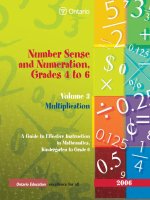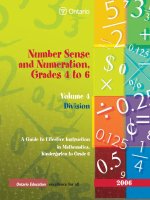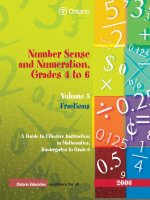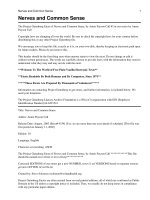Number Operations and Number Sense
Bạn đang xem bản rút gọn của tài liệu. Xem và tải ngay bản đầy đủ của tài liệu tại đây (168.72 KB, 12 trang )
B
ASIC PROBLEM SOLVING
in mathematics is rooted in whole number math facts, mainly addition
facts and multiplication tables. If you are unsure of any of these facts, now is the time to review.
Make sure to memorize any parts of this review that you find troublesome. Your ability to work
with numbers depends on how quickly and accurately you can do simple mathematical computations.
Operations
Addition and Subtraction
Addition is used when you need to combine amounts. The answer in an addition problem is called the sum or
the total. It is helpful to stack the numbers in a column when adding. Be sure to line up the place-value columns
and to work from right to left.
CHAPTER
Number
Operations and
Number Sense
A GOOD grasp of the building blocks of math will be essential for
your success on the GED Mathematics Test. This chapter covers the
basics of mathematical operations and their sequence, variables, inte-
gers, fractions, decimals, and square and cube roots.
42
405
Example
Add 40 + 129 + 24.
1. Align the numbers you want to add. Since it is
necessary to work from right to left, begin with the
ones column. Since the ones column equals 13,
write the 3 in the ones column and regroup or
“carry” the 1 to the tens column:
1
40
129
+24
3
2. Add the tens column, including the regrouped 1.
1
40
129
+24
93
3. Then add the hundreds column. Since there is
only one value, write the 1 in the answer.
1
40
129
+24
193
Subtraction is used when you want to find the dif-
ference between amounts. Write the greater number
on top, and align the amounts on the ones column.
You may also need to regroup as you subtract.
Example
If Kasima is 45 and Deja is 36, how many years
older is Kasima?
1. Find the difference in their ages by subtracting.
Start with the ones column. Since 5 is less than the
number being subtracted (6), regroup or “borrow”
a ten from the tens column. Add the regrouped
amount to the ones column. Now subtract 15 − 6
in the ones column.
1
4
5
− 36
9
2. Regrouping 1 ten from the tens column left 3
tens. Subtract 3 − 3, and write the result in the tens
column of your answer. Kasima is 9 years older
than Deja. Check: 9 + 36 = 45.
1
4
3
5
−36
09
Multiplication and Division
In multiplication, you combine the same amount multi-
ple times. For example, instead of adding 30 three times,
30 + 30 + 30, you could simply multiply 30 by 3. If a
problem asks you to find the product of two or more
numbers, you should multiply.
Example
Find the product of 34 and 54.
1. Line up the place values as you write the prob-
lem in columns. Multiply the ones place of the top
number by the ones place of the bottom number:
4 × 4 = 16. Write the 6 in the ones place in the first
partial product. Regroup the ten.
1
34
× 54
6
2. Multiply the tens place in the top number by 4:
4 × 3 = 12. Then add the regrouped amount 12 + 1
= 13. Write the 3 in the tens column and the 1 in
the hundreds column of the partial product.
1
34
× 54
136
3. Now multiply by the tens place of 54. Write a
placeholder 0 in the ones place in the second partial
product, since you’re really multiplying the top
number by 50. Then multiply the top number by 5:
5 × 4 = 20. Write 0 in the partial product and
regroup the 2. Multiply 5 × 3 = 15. Add the
regrouped 2: 15 + 2 = 17.
–
NUMBER OPERATIONS AND NUMBER SENSE
–
406
34
× 54
136
170 —place holder
4. Add the partial products to find the total prod-
uct: 136 + 1,700 = 1,836.
34
× 54
136
1700
1,836
In division, the answer is called the quotient.The
number you are dividing by is called the divisor and the
number being divided is the dividend. The operation of
division is finding how many equal parts an amount can
be divided into.
Example
At a bake sale, three children sold their baked
goods for a total of $54. If they share the money
equally, how much money should each child
receive?
1. Divide the total amount ($54) by the number of
ways the money is to be split (3). Work from left to
right. How many times does 3 go into 5? Write the
answer, 1, directly above the 5 in the dividend.
Since 3 × 1 = 3, write 3 under the 5 and subtract
5 − 3 = 2.
18
3ͤ54
ෆ
−
3
24
−24
0
2. Continue dividing. Bring down the 4 from the
ones place in the dividend. How many times does 3
go into 24? Write the answer, 8, directly above the 4
in the dividend. Since 3 × 8 = 24, write 24 below
the other 24 and subtract 24 − 24 = 0.
3. If you get a number other than zero after your
last subtraction, this number is your remainder.
Example
9 divided by 4.
2
4ͤ9
ෆ
−8
1—remainder
The answer is 2 R1.
Sequence of Mathematical
Operations
There is an order for doing a sequence of mathematical
operations. That order is illustrated by the following
acronym PEMDAS, which can be remembered by using
the first letter of each of the words in the phrase: Please
Excuse My Dear Aunt Sally. Here is what it means
mathematically:
P: Parentheses. Perform all operations within
parentheses first.
E: Exponents. Evaluate exponents.
M/D: Multiply/ Divide. Work from left to right in
your expression.
A/S: Add/Subtract. Work from left to right in your
expression.
Example
ᎏ
(5 +
4
3)
2
ᎏ
+ 27 = Add 5 to 3 within parentheses.
ᎏ
(8
4
)
2
ᎏ
+ 27 = Next, evaluate the exponential
expression.
ᎏ
6
4
4
ᎏ
+ 27 = Perform division.
16 + 27 = 43 Perform addition.
Squares and Cube Roots
The square of a number is the product of a number and
itself. For example, in the expression 3
2
= 3 × 3 = 9, the
number 9 is the square of the number 3. If we reverse the
process, we can say that the number 3 is the square root
of the number 9. The symbol for square root is ͙
ෆ
and
it is called the radical. The number inside of the radical
is called the radicand.
0
–
NUMBER OPERATIONS AND NUMBER SENSE
–
407
Example
5
2
= 25 therefore ͙25
ෆ
= 5
Since 25 is the square of 5, it is also true that 5 is
the square root of 25.
Perfect Squares
The square root of a number might not be a whole num-
ber. For example, the square root of 7 is 2.645751311 . . .
It is not possible to find a whole number that can be
multiplied by itself to equal 7. A whole number is a per-
fect square if its square root is also a whole number.
Examples of perfect squares:
1, 4, 9, 16, 25, 36, 49, 64, 81, 100 . . .
Numbers and Signs
Odd and Even Numbers
An even number is a number that can be divided by the
number 2 with a whole number: 2, 4, 6, 8, 10, 12, 14 . . .
An odd number cannot be divided by the number 2 as a
result: 1, 3, 5, 7, 9, 11, 13 ...The even and odd numbers
listed are also examples of consecutive even numbers,
and consecutive odd numbers because they differ by two.
Here are some helpful rules for how even and odd
numbers behave when added or multiplied:
even + even = even and even ؋ even = even
odd + odd = even and odd ؋ odd = odd
odd + even = odd and even ؋ odd = even
Prime and Composite Numbers
A positive integer that is greater than the number 1 is
either prime or composite, but not both. A factor is an
integer that divides evenly into a number.
■
A prime number has only itself and the number 1
as factors.
Examples: 2, 3, 5, 7, 11, 13, 17, 19, 23 . . .
■
A composite number is a number that has more
than two factors.
Examples: 4, 6, 8, 9, 10, 12, 14, 15, 16 . . .
■
The number 1 is neither prime nor composite.
Number Lines and Signed
Numbers
You have surely dealt with number lines in your distin-
guished career as a math student. The concept of the
number line is simple: Less than is to the left and greater
than is to the right . . .
Absolute Value
The absolute value of a number or expression is always
positive because it is the distance of a number from zero
on a number line.
Example
ԽϪ1Խϭ1 Խ2 Ϫ 4ԽϭԽϪ2Խϭ2
Working with Integers
An integer is a positive or negative whole number. Here
are some rules for working with integers:
Multiplying and Dividing
(+) × (+) = + (+) Ϭ (+) = +
(+) × (−) = − (+) Ϭ (−) = −
(−) × (−) = + (−) Ϭ (−) = +
A simple rule for remembering the above is that if the
signs are the same when multiplying or dividing, the
answer will be positive, and if the signs are different, the
answer will be negative.
Adding
Adding the same sign results in a sum of the same sign:
(+) + (+) = + and (−) + (−) = −
When adding numbers of different signs, follow this
two-step process:
1. Subtract the absolute values of the numbers.
2. Keep the sign of the larger number.
–7 –6 –5 –4 –3 –2 –1 0 1 2 3 4 5 6 7
Greater Than
Less Than
–
NUMBER OPERATIONS AND NUMBER SENSE
–
408
Example
−2 + 3 =
1. Subtract the absolute values of the numbers:
3 − 2 = 1
2. The sign of the larger number (3) was originally
positive, so the answer is positive 1.
Example
8 + −11 =
1. Subtract the absolute values of the numbers:
11 − 8 = 3
2. The sign of the larger number (11) was origi-
nally negative, so the answer is −3.
Subtracting
When subtracting integers, change all subtraction to
addition and change the sign of the number being sub-
tracted to its opposite. Then, follow the rules for addition.
Examples
(+10) − (+12) = (+10) + (−12) = −2
(−5) − (−7) = (−5) + (+7) = +2
Decimals
The most important thing to remember about decimals
is that the first place value to the right is tenths. The place
values are as follows:
In expanded form, this number can be expressed as:
1,268.3457 = (1 × 1,000) + (2 × 100) + (6 × 10)
+ (8 × 1) + (3 × .1) + (4 × .01) + (5 × .001)
+ (7 × .0001)
Comparing Decimals
Comparing decimals is actually quite simple. Just line up
the decimal points and fill in any zeroes needed to have
an equal number of digits.
Example
Compare .5 and .005
Line up decimal points .500
and add zeroes .005
Then ignore the decimal point and ask, which is
bigger: 500 or 5?
500 is definitely bigger than 5, so .5 is larger
than .005.
Variables
In a mathematical sentence, a variable is a letter that rep-
resents a number. Consider this sentence: x + 4 = 10. It’s
easy to figure out that x represents 6. However, problems
with variables on the GED will become much more com-
plex than that, and there are many rules and procedures
that need to be learned. Before you learn to solve equa-
tions with variables, you need to learn how they operate
in formulas. The next section on fractions will give you
some examples.
Fractions
To do well when working with fractions, it is necessary to
understand some basic concepts. On the next page are
some math rules for fractions using variables.
1
T
H
O
U
S
A
N
D
S
2
H
U
N
D
R
E
D
S
6
T
E
N
S
8
O
N
E
S
•
D
E
C
I
M
A
L
3
T
E
N
T
H
S
4
H
U
N
D
R
E
D
T
H
S
5
T
H
O
U
S
A
N
D
T
H
S
7
T
E
N
T
H
O
U
S
A
N
D
T
H
S
POINT
–
NUMBER OPERATIONS AND NUMBER SENSE
–
409









